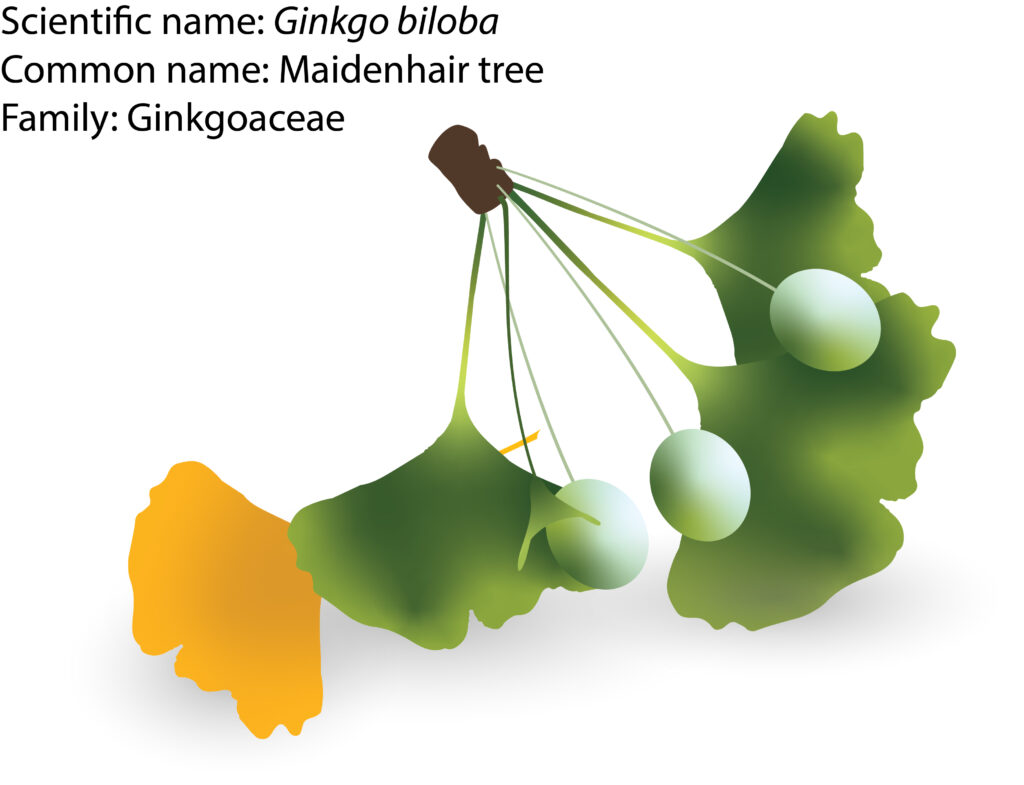The Ginkgoales, which are deciduous seed-bearing plants more primitive than the conifers and even more ancient, first appeared in the Permian Period (about 300 million years ago) and thrived throughout the Jurassic and Cretaceous periods. Approximately 100 million years ago, they began to decline, leaving the maidenhair tree as the sole survivor in the family Ginkgoaceae, and only in China. Therefore, it is known as a living fossil, as the rest of the species in the genus became extinct over time based on fossil records. The Ginkgo tree is the national tree of China. It is now unknown in the wild, and it would probably no longer exist if ancient trees had not been preserved in temple grounds and young ones planted there.
The name “Ginkgo” is a phonetic translation of the Japanese name for the tree, and “biloba” in Ginkgo biloba refers to the two separate lobes of the tree. It is commonly known as the silver apricot. The term “maidenhair” in the common name “maidenhair tree” refers to the leaf shape and vein pattern, which resemble some species of maidenhair fern (Adiantum). Ginkgo is a dioecious gymnosperm, with male trees bearing small spikes of pollen sacs and female trees producing solitary naked seeds (“fruits”) with an oily flesh surrounding the large kernel.
A tree adapted to temperate climates, the Ginkgo resists pollution and appears to have outlived any pests it may have once had. However, it does require shelter from strong winds and thrives in deep, fertile soil. Ginkgo is cultivated across a wide range of moisture and temperature conditions. In urban areas, male trees are preferred by city authorities as female trees produce smelly fruit. In China, on the other hand, female trees are favored because their seeds are edible and nutritious. The fruit does not appear until the tree is at least 20 years old.
This ancient plant can grow to a height of at least 80 feet. When young, the tree has an upright canopy that eventually spreads to 30 feet or more. It typically has deep roots and is resistant to wind and snow damage. Its leaves are fan-shaped, matte green, and about 4 inches long, turning golden yellow in autumn. In late summer and fall, a fleshy, plum-like orange-brown fruit with an edible kernel may appear if male and female trees are grown together. There are specific cultivars available, such as ‘Fastigiata,’ which is a slender and erect variety reaching 30 feet, and ‘Princeton Sentry,’ a male plant with a narrow and upright habit. Ginkgo can be propagated from seeds or cuttings in the fall.
Ginkgo is widely planted for its industrial, ornamental, and medicinal uses. It has been introduced and extensively planted in various countries, including Korea and Japan. Ginkgo trees rarely suffer from pest and disease problems in urban conditions, making them excellent choices for urban and shade trees. Their beauty is highly valued, which is why they are often planted along many streets. Additionally, they are popular for bonsai cultivation, as they can be carefully maintained and kept small over centuries through horticultural care.
The leaves and nuts of the ginkgo tree have been used for thousands of years in traditional medicine. With modern technology, ginkgo extract has been proven to improve conditions such as poor blood circulation, hypertension, poor memory, Alzheimer’s disease treatment or prevention, depression, and male impotence.
Ginkgo is not only valued for its traditional medicinal uses but also for its remarkable array of beneficial compounds. It contains a rich combination of flavone glycosides, isorhamnetin, quercetin, karmpferol derivatives, bioflavonoids, organic acids, and terpenoids. These bioactive compounds contribute to the plant’s incredible properties and have garnered attention in modern research. Ginkgo exhibits antioxidant power to combat oxidative stress, reduces inflammation in the body, shows potential in fighting cancer, and plays a role in memory enhancement and cognitive function.
In addition, it has been associated with positive effects on conditions such as diabetes, obesity, and cardiovascular health. Its versatile nature extends to antimicrobial activity, liver protection, mood improvement, and immune system modulation. Extensive range of benefits on ginkgo consumption makes it a truly remarkable plant with the potential to support overall well-being.

Further reading:
Belwal, T., Giri, L., Bahukhandi, A., Tariq, M., Kewlani, P., Bhatt, I. D., & Rawal, R. S. (2019). Ginkgo biloba. In Nonvitamin and nonmineral nutritional supplements (pp. 241-250). Academic Press.
Chan, P. C., Xia, Q., & Fu, P. P. (2007). Ginkgo biloba leave extract: biological, medicinal, and toxicological effects. Journal of environmental science and health part C, 25(3), 211-244.
Das, R., Lami, M. S., Chakraborty, A. J., Mitra, S., Tallei, T. E., Idroes, R., … & Emran, T. B. (2022). Ginkgo biloba: a treasure of functional phytochemicals with multimedicinal applications. Evidence-based Complementary and Alternative Medicine, 2022.
Johnson, S. L. (1994). Tissue culture of Ginkgo biloba. Bios, 193-200.
Stanković, M. S. (2016). Biology and ecology of Ginkgo biloba L.(Ginkgoaceae). Ginkgo biloba, 1.